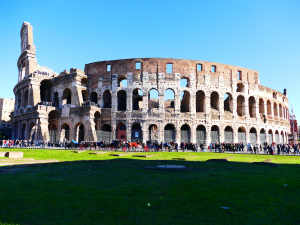The Colosseum, Roman Forum, and Palatine Hill are three of Rome’s most iconic historical sites, each telling a different part of the story of Ancient Rome. Together, they offer a remarkable glimpse into the grandeur and complexity of one of history’s most influential civilizations. These landmarks are not only physically impressive but are rich in historical, political, and cultural significance, drawing millions of visitors each year who seek to step back in time and experience the ancient world.
The Colosseum: The Arena of Gladiators
The Colosseum, also known as the Flavian Amphitheatre, is perhaps the most famous symbol of ancient Roman architecture and engineering. Built in the 1st century AD under Emperor Vespasian and completed by his son Titus, the Colosseum was designed to host spectacular public spectacles, including gladiator contests, mock naval battles, animal hunts, and executions. It could hold up to 80,000 spectators, who gathered to witness these brutal events as a form of entertainment and a demonstration of Roman power.
The Colosseum’s advanced design is a testament to Roman ingenuity, with a complex system of arches, vaults, and corridors that allowed the efficient movement of both spectators and participants. Despite the ravages of time, earthquakes, and plundering, much of the structure still stands today, offering visitors an awe-inspiring view of ancient Roman engineering and the harsh realities of the empire’s entertainment.
The Roman Forum: The Heart of Ancient Rome
The Roman Forum was the political, commercial, and social heart of ancient Rome. Located between the Palatine Hill and the Capitoline Hill, it was a bustling center where citizens gathered for important public events, including elections, speeches, and religious ceremonies. The Forum also housed several of Rome’s most important temples, basilicas, and government buildings.
Some of the most notable structures within the Roman Forum include the Temple of Saturn, the Temple of Vesta, and the Senate House, where the Roman Senate would convene. Walking through the ruins of the Roman Forum today, visitors can imagine the once-vibrant life that occurred here, where the fate of the Roman Republic and later the Roman Empire was shaped. The Arch of Titus and the Basilica of Maxentius and Constantine are just a few of the remarkable remnants that continue to stand as a testament to Rome’s architectural and political legacy.
Palatine Hill: The Birthplace of Rome
Standing above the Roman Forum is Palatine Hill, one of the seven hills of Rome and the most historically significant. According to Roman mythology, it is the site of the founding of Rome, as it was here that Romulus and Remus, the twin brothers raised by a she-wolf, are said to have established the city. Over time, the Palatine Hill became the residence of Rome’s emperors and aristocracy. The hill was home to luxurious palaces, including the grand Palace of Augustus and the Domus Flavia of Emperor Domitian.
The Palatine Hill offers stunning views of the Roman Forum, the Colosseum, and other significant Roman landmarks. The archaeological remains found here provide insight into the wealth and power of the Roman elite, with impressive frescoes, gardens, and sculptures that once decorated the imperial palaces. Today, the Palatine Hill is a serene space where visitors can wander among the ruins and reflect on the city’s transformation from a humble settlement to the center of an empire.
Connecting the Three Landmarks: A Walk Through Roman History
The Colosseum, Roman Forum, and Palatine Hill are inextricably linked, forming a historical and cultural continuum that highlights the grandeur of ancient Rome. From the blood-stained arenas of the Colosseum to the political heart of the Forum and the imperial luxury of the Palatine Hill, these landmarks represent different aspects of Roman life, from entertainment and politics to power and mythology. Visiting them together provides a comprehensive understanding of how Rome once functioned—both as a republic and an empire.
Together, these sites stand as symbols of Rome’s enduring legacy and offer a fascinating window into one of the most influential civilizations in history. As you walk among the ruins, you can almost hear the echoes of the past—the roar of the crowds in the Colosseum, the speeches and debates in the Forum, and the whispered ambitions of emperors on the Palatine Hill. These ancient ruins continue to inspire awe and admiration, making them a must-see for anyone interested in history, architecture, or the legacy of the Roman Empire.

